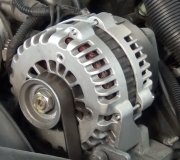I've been to classes where they talked about measuring the resistance of injectors but then they always mentioned there was some other underlying cause that fixed whatever problem they were having.
One real big problem GM has is mismatched injectors. Chrysler buys theirs from Bosch in flow-matched sets of four, six, or eight for each engine, and problems are unheard of. GM just grabs a handful out of a huge bin, and the flow rates are all different. They work well enough when the engine is new, but as characteristics change and wear takes place, those differences become more pronounced. If one flows a little less fuel volume, that cylinder runs a little lean. The oxygen sensor picks up the unburned oxygen in the exhaust. In response, the Engine Computer commands more fuel from all of the injectors. Five cylinders will be running rich which can lead to excessive unburned hydrocarbons out the tail pipe.
The fix for that is a set of flow-matched injectors. One company that specializes in that is owned by Jim Linder in Indianapolis. They rebuild and match injectors. GM injectors are their top seller. Many customers say their engines never ran so smoothly until they had new injectors installed.
As for testing the fuel pump, to be accurate, flow-testing has to be done after the pressure regulator in the return line. The ability to supply just enough fuel for the engine to run on isn't sufficient. If you tested the flow rate at the test port, you'll be bleeding off pressure before the regulator opens and lets fuel flow back to the tank. The pump has to be able to supply the needed volume at the needed pressure. (Think of a little toy air compressor that can deliver a whole pile of air flow if the hose is wide open, but if you try to build any respectable pressure, it can't deliver enough volume to run a small air tool). If you draw the fuel from the return line, you'll measure how much fuel can be supplied at the required pressure.
To test the injectors electrically, unplug them and use the ohm meter to measure resistance between the two terminals on each one. Typical is somewhere in the area of 6 to 12 ohms, as I recall. Instead of a correct value, look for consistency between them. The meter leads will have a couple of ohms of resistance too so that has to be factored into the readings. I never measured injector resistance, so I don't know what that's going to tell you. If they're buried and inaccessible, look for a connector in the wiring harness that you can get to. You'll have to figure out which terminal is the common one and put one meter lead there, then find the other six, one for each injector, and measure each of those.
It sounds like you might have moved to California. Various parts of the country have different fuel formulations depending on the whims of the uninformed politicians, and California is the worst. Besides a ton of new groundwater contamination problems they caused, the fuel is well-known to cut fuel mileage by over ten percent. Between pump pressure and volume, and mismatched injectors, you may have had a minor problem all along that went unnoticed until you started using the different fuel.
Wednesday, August 24th, 2011 AT 9:27 PM




